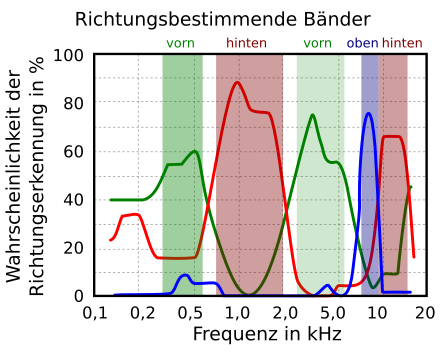Blauert's ribbons
As blue tsche bands (by Jens Blauert ), direction-determining bands , or direction-determining frequency bands is referred to in the psychoacoustics the acoustic frequency ranges for the human directional hearing in the median plane (front, rear upper ...) are important.
Basics
If the sound level is raised in one of these bands with a sound source positioned at the front compared to other frequency ranges, the hearing can use this to determine whether the sound is virtually coming from the front, from above or from behind.
The figure shows the frequency-dependent relative reporting frequency of test persons. It is z. For example, it can be seen that the “back” direction is most reliably detected , namely with over 80 percent probability, in the frequency range around 1 kHz .
Localization in the median plane
The numerous elevations and depressions of the outer ear , together with the auditory canal, constitute an acoustic resonator system that is excited depending on the direction of sound incidence . This creates a direction-dependent filter whose spectral maxima and minima depend on the direction of incidence of the sound. They are evaluated by the ear and the directions in front, up and behind are derived from them. This localization in the median plane, with a localization sharpness of around 10 °, is considerably less precise than z. B. the horizontal localization over time - and level differences between both ears with 1 °.
Sound engineering
The direction-dependent discoloration of the sound caused by Blauert's bands can be simulated electronically and thus create the auditory impression that the sound is coming from the front, above, behind or below. However, this only works with mixed sounds that are familiar to the listener. When shooting in artificial head - Stereofonie the discoloration and with them the location information is included anyway.
With loudspeaker stereophony (i.e. in the horizontal plane) the original direction-determining bands v (front), h (back) and o (top) of the median plane can be easily reinterpreted as two directionless hearing sensations “ present ” and “ diffuse ”. This is also noteworthy for the equalizer settings for the sound processing in stereophony and the surround sound of broadband signals. Where:
- front v = present in the sound , close, direct, superficial - this can be achieved by increasing the frequencies 300 to 400 Hz and 3 to 4 kHz as well as lowering frequencies by 1 kHz.
- back h (and above o) = diffuse , distant and spatial in the sound - this can be achieved by increasing the frequencies by 1 kHz.
In audio engineering, it is known to “de- mulm ” the sound with the “ bathtub filter ”, which lowers the sound around 1 kHz, roughly in the middle of the spectrum (Q = 0.6 to 1.4) by up to 6 dB . This achieves a certain clarity and superficiality in the sound. In this way, a hi-fi sound e.g. B. feigned in the speaker demonstration.
See also
- Audio event direction | Speaker base
- Mono | Quadrofonie | 5.1
- Distance law | Duplex theory
- Binaural | Interaural | Vowel triangle
- List of audio terms
literature
- Jens Blauert: Spatial hearing . Hirzel, Stuttgart 1974, ISBN 3-7776-0250-7 .
- Jens Blauert: Spatial Hearing. The Psychophysics of Human Sound Localization . Revised edition. The MIT Press, Cambridge MA et al. 1997, ISBN 0-262-02413-6 .
Web links
- Direction perception not only in the median level , sengpielaudio.com (PDF; 251 kB)
- Frequency position of the vowel formants and the Blauert bands , sengpielaudio.com (PDF; 308 kB)
- The importance of Blauert's tapes for sound recording , sengpielaudio.com (PDF; 365 kB)
- Directional bands and curves of equal volume , sengpielaudio.com (PDF; 482 kB)
- Presence filter for stereo based on the principle of directional bands , sengpielaudio.com (PDF; 744 kB)
